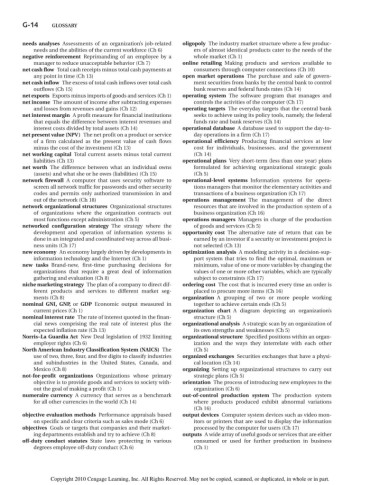Page 688 - Introduction to Business
P. 688
G-14 GLOSSARY
needs analyses Assessments of an organization’s job-related oligopoly The industry market structure where a few produc-
needs and the abilities of the current workforce (Ch 6) ers of almost identical products cater to the needs of the
negative reinforcement Reprimanding of an employee by a whole market (Ch 1)
manager to reduce unacceptable behavior (Ch 7) online retailing Making products and services available to
net cash flow Total cash receipts minus total cash payments at consumers through computer connections (Ch 10)
any point in time (Ch 13) open market operations The purchase and sale of govern-
net cash inflow The excess of total cash inflows over total cash ment securities from banks by the central bank to control
outflows (Ch 15) bank reserves and federal funds rates (Ch 14)
net exports Exports minus imports of goods and services (Ch 1) operating system The software program that manages and
net income The amount of income after subtracting expenses controls the activities of the computer (Ch 17)
and losses from revenues and gains (Ch 12) operating targets The everyday targets that the central bank
net interest margin A profit measure for financial institutions seeks to achieve using its policy tools, namely, the federal
that equals the difference between interest revenues and funds rate and bank reserves (Ch 14)
interest costs divided by total assets (Ch 14) operational database A database used to support the day-to-
net present value (NPV) The net profit on a product or service day operations in a firm (Ch 17)
of a firm calculated as the present value of cash flows operational efficiency Producing financial services at low
minus the cost of the investment (Ch 13) cost for individuals, businesses, and the government
net working capital Total current assets minus total current (Ch 14)
liabilities (Ch 13) operational plans Very short-term (less than one year) plans
net worth The difference between what an individual owns formulated for achieving organizational strategic goals
(assets) and what she or he owes (liabilities) (Ch 15) (Ch 5)
network firewall A computer that uses security software to operational-level systems Information systems for opera-
screen all network traffic for passwords and other security tions managers that monitor the elementary activities and
codes and permits only authorized transmission in and transactions of a business organization (Ch 17)
out of the network (Ch 18) operations management The management of the direct
network organizational structures Organizational structures resources that are involved in the production system of a
of organizations where the organization contracts out business organization (Ch 16)
most functions except administration (Ch 5) operations managers Managers in charge of the production
networked configuration strategy The strategy where the of goods and services (Ch 5)
development and operation of information systems is opportunity cost The alternative rate of return that can be
done in an integrated and coordinated way across all busi- earned by an investor if a security or investment project is
ness units (Ch 17) not selected (Ch 13)
new economy An economy largely driven by developments in optimization analysis A modeling activity in a decision-sup-
information technology and the Internet (Ch 1) port system that tries to find the optimal, maximum or
new tasks Brand-new, first-time purchasing decisions for minimum, value of one or more variables by changing the
organizations that require a great deal of information values of one or more other variables, which are typically
gathering and evaluation (Ch 8) subject to constraints (Ch 17)
niche marketing strategy The plan of a company to direct dif- ordering cost The cost that is incurred every time an order is
ferent products and services to different market seg- placed to procure more items (Ch 16)
ments (Ch 8) organization A grouping of two or more people working
nominal GNI, GNP, or GDP Economic output measured in together to achieve certain ends (Ch 5)
current prices (Ch 1) organization chart A diagram depicting an organization’s
nominal interest rate The rate of interest quoted in the finan- structure (Ch 5)
cial news comprising the real rate of interest plus the organizational analysis A strategic scan by an organization of
expected inflation rate (Ch 13) its own strengths and weaknesses (Ch 5)
Norris–La Guardia Act New Deal legislation of 1932 limiting organizational structure Specified positions within an organ-
employer rights (Ch 6) ization and the ways they interrelate with each other
North American Industry Classification System (NAICS) The (Ch 5)
use of two, three, four, and five digits to classify industries organized exchanges Securities exchanges that have a physi-
and subindustries in the United States, Canada, and cal location (Ch 14)
Mexico (Ch 8) organizing Setting up organizational structures to carry out
not-for-profit organizations Organizations whose primary strategic plans (Ch 5)
objective is to provide goods and services to society with- orientation The process of introducing new employees to the
out the goal of making a profit (Ch 1) organization (Ch 6)
numeraire currency A currency that serves as a benchmark out-of-control production system The production system
for all other currencies in the world (Ch 14) where products produced exhibit abnormal variations
(Ch 16)
objective evaluation methods Performance appraisals based output devices Computer system devices such as video mon-
on specific and clear criteria such as sales mode (Ch 6) itors or printers that are used to display the information
objectives Goals or targets that companies and their market- processed by the computer for users (Ch 17)
ing departments establish and try to achieve (Ch 8) outputs A wide array of useful goods or services that are either
off-duty conduct statutes State laws protecting in various consumed or used for further production in business
degrees employee off-duty conduct (Ch 6) (Ch 1)
Copyright 2010 Cengage Learning, Inc. All Rights Reserved. May not be copied, scanned, or duplicated, in whole or in part.

